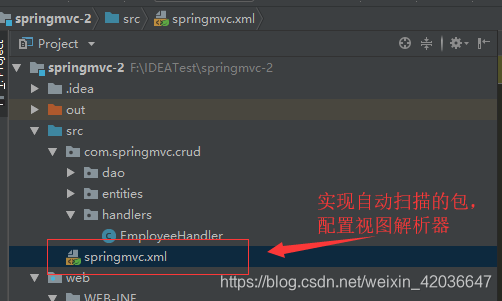ok,上一章已经把基本需要的javabean以及dao类建立起来了。那么接下来的工作就是写页面的显示效果,然后完成点击后的handler处理请求的方法,显示到页面上即可。
这一章的主要教大家实现查询操作。
一 、XML配置
首先在web/WEN-INF/目录下创建一个views目录,里面存放你想展示的视图,我们先在里面创建一个list.jsp,用来展示数据库的所有数据。

接着在src目录下写好 springmvc.xml配置文件

springmvc.xml
<?xml version="1.0" encoding="UTF-8"?>
<beans xmlns="http://www.springframework.org/schema/beans"
xmlns:xsi="http://www.w3.org/2001/XMLSchema-instance"
xmlns:context="http://www.springframework.org/schema/context"
xmlns:mvc="http://www.springframework.org/schema/mvc"
xsi:schemaLocation="http://www.springframework.org/schema/beans http://www.springframework.org/schema/beans/spring-beans.xsd http://www.springframework.org/schema/context http://www.springframework.org/schema/context/spring-context.xsd http://www.springframework.org/schema/mvc http://www.springframework.org/schema/mvc/spring-mvc.xsd">
<!--配置自动扫描的包-->
<context:component-scan base-package="com.springmvc"></context:component-scan>
<!--配置视图解析器-->
<bean class="org.springframework.web.servlet.view.InternalResourceViewResolver">
<property name="prefix" value="/WEB-INF/views/"></property>
<property name="suffix" value=".jsp"></property>
</bean>
<mvc:default-servlet-handler/>
<mvc:annotation-driven></mvc:annotation-driven>
<mvc:resources mapping="/scripts/**" location="WEB-INF/scripts/"/>
</beans>
然后配置web.xml
<?xml version="1.0" encoding="UTF-8"?>
<web-app xmlns="http://xmlns.jcp.org/xml/ns/javaee"
xmlns:xsi="http://www.w3.org/2001/XMLSchema-instance"
xsi:schemaLocation="http://xmlns.jcp.org/xml/ns/javaee http://xmlns.jcp.org/xml/ns/javaee/web-app_4_0.xsd"
version="4.0">
<!--配置SpringMVC的 DispatcherServlet-->
<servlet>
<servlet-name>springDispatcherServlet</servlet-name>
<servlet-class>org.springframework.web.servlet.DispatcherServlet</servlet-class>
<init-param>
<param-name>contextConfigLocation</param-name>
<param-value>classpath:springmvc.xml</param-value>
</init-param>
<load-on-startup>1</load-on-startup>
</servlet>
<!--Map all requests to the DispatcherServlet for handling-->
<servlet-mapping>
<servlet-name>springDispatcherServlet</servlet-name>
<url-pattern>/</url-pattern>
</servlet-mapping>
</web-app>
初步的xml配置就完成了。
二、处理请求
在index.jsp页面写一个简单的< a>标签 ,作用就是通过我们的handler方法将数据放在request域中 ,再跳转到 list.jsp显示出来。
index.jsp
<%@ page contentType="text/html;charset=UTF-8" language="java" %>
<html>
<head>
<title>$Title$</title>
</head>
<body>
<a href="emps">List All Employees</a> //这里的href对应的是之后写的handler方法的@requestMapping
</body>
</html>
那么我们开始写handler方法,在com.springmvc.crud下创建一个包handlers,再创建一个类EmployeeHandler.java

开始编写
EmployeeHandler.java
package com.springmvc.crud.handlers;
import com.springmvc.crud.dao.DepartmentDao;
import com.springmvc.crud.dao.EmployeeDao;
import com.springmvc.crud.entities.Employee;
import org.springframework.beans.factory.annotation.Autowired;
import org.springframework.stereotype.Controller;
import org.springframework.web.bind.annotation.*;
import java.util.Map;
@Controller
public class EmployeeHandler {
@Autowired
private EmployeeDao employeeDao;
@Autowired
private DepartmentDao departmentDao;
@RequestMapping("/emps")
public String list(Map<String,Object> map){
map.put("employees",employeeDao.getAll());
return "list";
}
}

接着让我们来搞定list.jsp的显示
<%@ page contentType="text/html;charset=UTF-8" language="java" %>
<%@ taglib prefix="c" uri="http://java.sun.com/jsp/jstl/core" %>
<html>
<head>
<meta http-equiv="Content-Type" content="text/html;charset=UTF-8">
<title>Title</title>
</head>
<body>
<c:if test="${empty requestScope.employees}">
当前没有数据
</c:if>
<c:if test="${!empty requestScope.employees}">
<table border="1" cellspacing="0" cellpadding="10">
<tr>
<th>ID</th>
<th>LastName</th>
<th>Email</th>
<th>Gender</th>
<th>Department</th>
<th>Edit</th>
<th>Delete</th>
</tr>
<c:forEach items="${requestScope.employees}" var="emp">
<tr>
<td>${emp.id}</td>
<td>${emp.lastName}</td>
<td>${emp.email}</td>
<td>${emp.gender == 0 ? "Female" : "Male"}</td>
<td>${emp.department.departmentName}</td>
<td><a href="emp/${emp.id}">Edit</a></td>
<td><a class="delete" href="emp/${emp.id}">Delete</a></td>
</tr>
</c:forEach>
</table>
</c:if>
<br><br>
</body>
</html>
三、显示效果:
在点击了index.jsp的< a>标签后
